International Toy Fair Nuremberg 2009
Internationale Spielwarenmesse Nürnberg 2009
| x |
|
|
|
|
|
|
|
|
|
|
|
|
|
|
|
|
|
|
|
|
|
|
|
|
|
|
|
|
|
|
|
|
|
| What's Your Game? |
|
| x |
|
|
|
|
|
|
|
|
|
|
|
|
|
|
|
|
|
x |
|
|
|
|
|
|
|
|
|
|
|
|
|
|
|
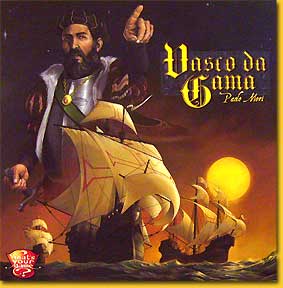 |
|
Discover new land, and score the most points with it, is what players have to do in this game.
Beginning with the start player, each player takes one numbered disc and places it on top of his own coloured disc in one of the five areas of the board. A Vasco da Gama tile states a number; everything above this number is free of charge, anything below will have to be paid for, so players will take this into account when taking numbered discs. When all players have placed four discs, the discs are worked by number. But first a second Vasco da Gama tile is turned to give a modifier on the number, from +3 to -3. At the same time this tile will be used as the new tile for the next turn. |
 xxxxx xxxxx |
| x |
|
|
|
|
|
|
|
|
|
|
|
|
|
|
|
|
|
|
|
|
|
|
|
|
|
|
|
|
|
|
|
|
|
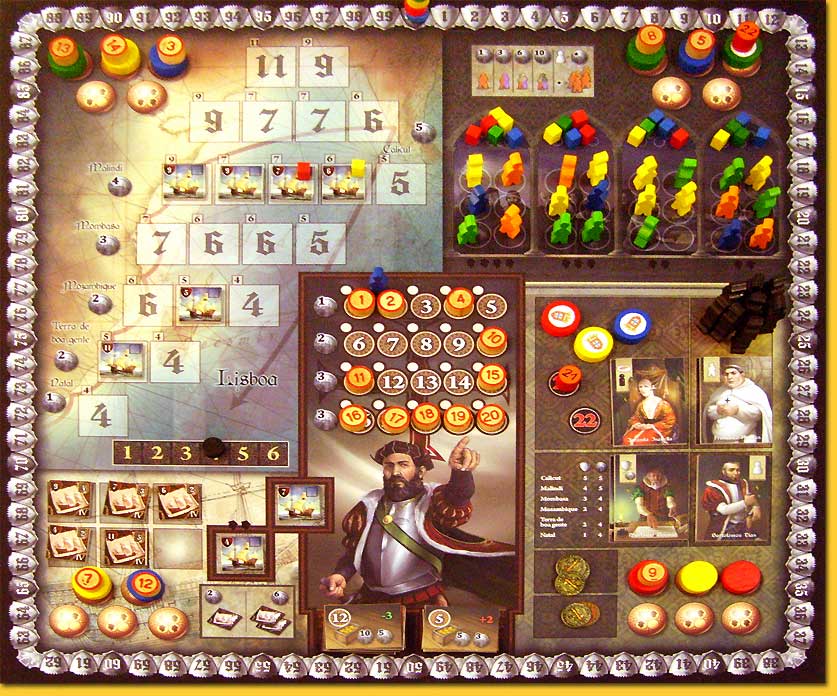 |
| x |
|
|
|
|
|
|
|
|
|
|
|
|
|
|
|
|
|
|
|
|
|
|
|
|
|
|
|
|
|
|
|
|
|
The player with the lowest numbered disc takes his action in the area of that disc; then the player with the next lower disc may take an action, and so on, until all discs have been worked. The higher discs may assure a player of free actions, but then he will not be the first to take the action in an area. It might even be that there is not any space left for his disc, as there are only five to six spaces per area - players may place more than one disc in an area.
In the crew area players may hire crew and a captain, but this costs money. The captain costs the amount of hired crew; the crew itself cost one for one, three for two, six for three, and four for ten, ah well, we know the series. |
|
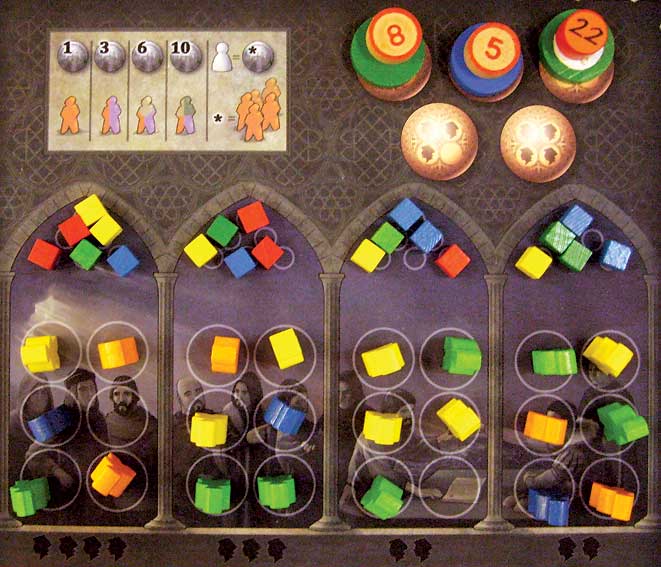 |
| x |
|
|
|
|
|
|
|
|
|
|
|
|
|
|
|
|
|
|
|
|
|
|
|
|
|
|
|
|
|
|
|
|
|
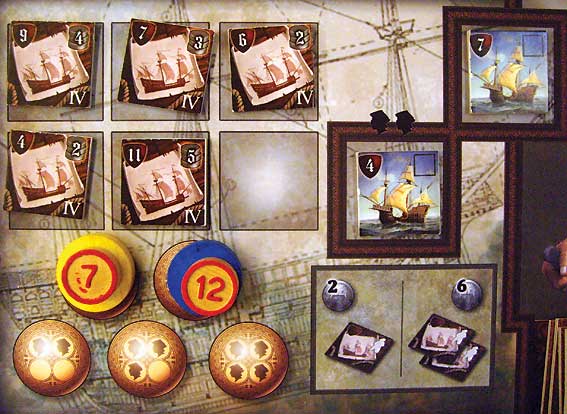 |
x |
Each round there is a window of ships. The number on the left is the navigation strength, the number on the right is the required amount of different crew. Players choose a ship, pay for the crew and turn the tile to its other side - with a captain on top. Thay remain in front of the players, until they have chosen an action in the navigation area.
The Roman numbers on the bottom right of the ship tile show in which round the tiles show up. |
|
| x |
|
|
|
|
|
|
|
|
|
|
|
|
|
|
|
|
|
|
|
|
|
|
|
|
|
|
|
|
|
|
|
|
|
In the navigation area, a player takes his ship and places it in a row of his choice, but he has to take care not to exceed the navigation strength of the ship: the square where he places his ship must have a value equal or less of the navigation strength. Higher rows are more rewarding, so buying a more expensive ship could be a good investment.
On the left of the row, below the name of the supposed location the ship sails to, is the amount of points a player scores immediately.
Whenever a row of ships is complete; the ships move to the row above, starting with the ship with the highest navigation, when tied, the left one of the concerned ships.
Each round all ships on each row earn points, so sailing early with a small ship could be as rewarding as taking a larger ship that would start in a higher and more point scoring row. |
|
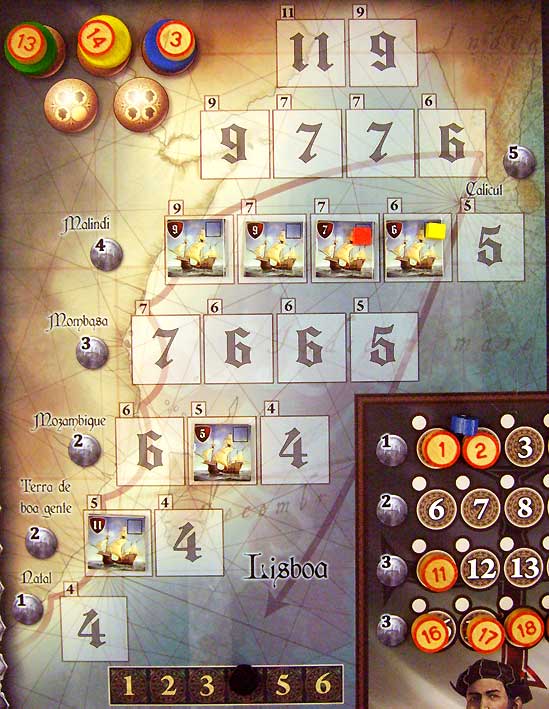 |
| x |
|
|
|
|
|
|
|
|
|
|
|
|
|
|
|
|
|
|
|
|
|
|
|
|
|
|
|
|
|
|
|
|
|
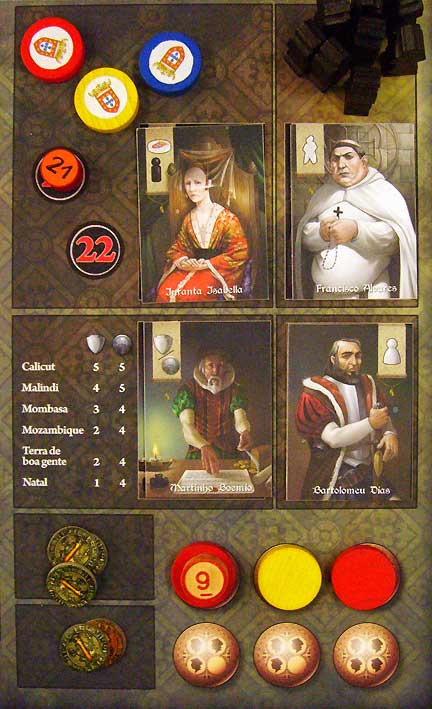 |
|
And here are the characters; what would a game be without nowadays?
The bishop entitles a player to play a sixth colour, black. In later rounds, there are ships that require five different type of crew, so this is when players would go for this card.
With Lady Isabella a player can take an extra action disc, with the accompanying '21'. With such a disc, a player never has to pay for this action, but he will be last in line when it comes to performing an action.
Bartholomew Dias gives a free captain on a ship, and Martinha Boemis' is good for extra points or money when bringing in a ship in the navigation area.
Character cards go to another player when they have chosen this as an action for their turn.
The Vasco da Gama tile from the beginning of a round also states how much money is placed in the two rectangles below the four characters.
Each round Vasco da Gama himself also sends one or two ships to sea, so if players don't send ships out, Vasco certainly will! |
|
| x |
|
|
|
|
|
|
|
|
|
|
|
|
|
|
|
|
|
|
|
|
|
|
|
|
|
|
|
|
|
|
|
|
|
The game lasts six rounds, after which the player with the most points has won.
'Vasco da Gama' is announced for Fall 2009.
Vasco da Gama, Paolo Mori, What's Your Game?, 2009 - 2 to 4 players, 12 years and up, 90 minutes |
|
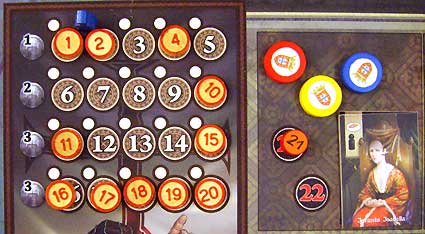 |
| x |
|
|
|
|
|
|
|
|
|
|
|
|
|
|
|
|
|
|
|
|
|
|
|
|
|
|
|
|
|
|
|
|
|
| x |
|
|
|
|
|
|
|
|
|
|
|
|
|
|
|
|
|
|
|
|
|
|
|
|
|
|
|
|
|
|
|
|
|
| x |
|
|
|
|
|
|
|
|
|
|
|
|
|
|
|
|
|
|
|
|
|
|
|
|
|
|
|
|
|
|
|
|
|
 |
|
|
|
|
|
|
|
|
|
|
|
|
|
|
|
|
|
|
|
|
|
|
|
|
|
|
|
|
|
|
|
|
 |
|
|
|
|
|
|
|
|
|
|
|
|
|
|
|
|
|
|
|
|
|
|
|
|
|
|
|
|
|
|
|
|
 |
|
|
|
|
|
|
|
|
|
|
|
|
|
|
|
|
|
|
|
|
|
|
|
|
|
|
|
|
|
|
|
|
 |
|
|
|
|
|
|
|
|
|
|
|
|
|
|
|
|
|
|
|
|
|
|
|
|
|
|
|
|
|
|
| x |
|
|
|
|
|
|
|
|
|
|
|
|
|
|
|
|
|
|
|
|
|
|
|
|
|
|
|
|
|
|
|
|
|
 |
|
|
|
|
|
|
|
|
|
|
|
|
|
|
|
|
|
|
|
|
|
|
|
|
|
|
|
|
|
|
|
|
|
|
|
|
|
|
|
|
|
|
|
|
|
|
|
|
|
|
|